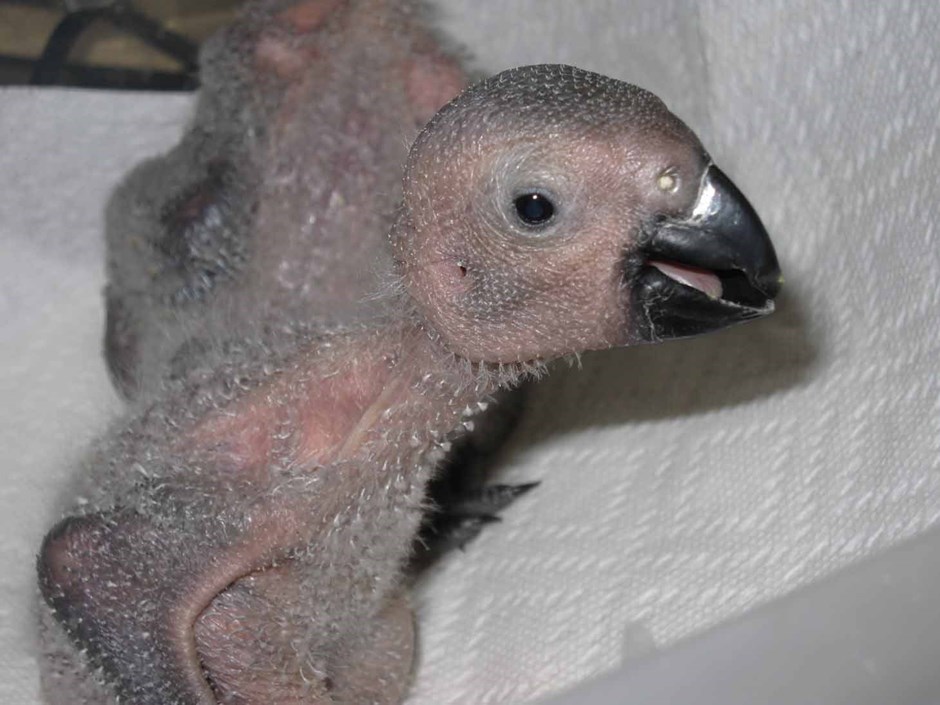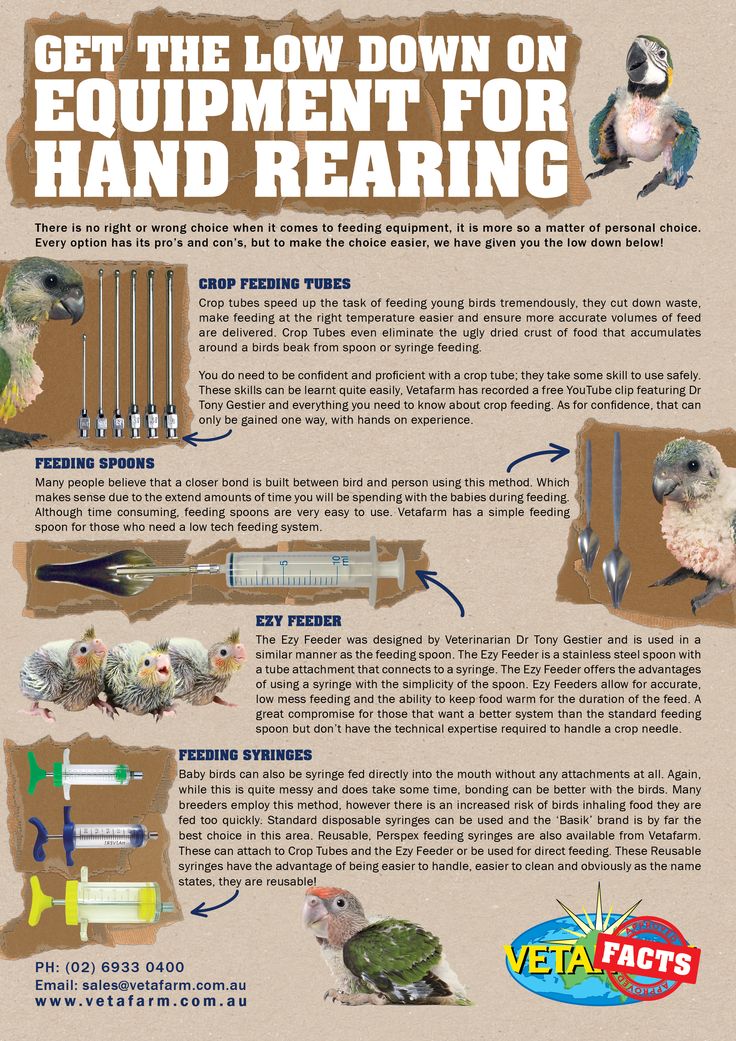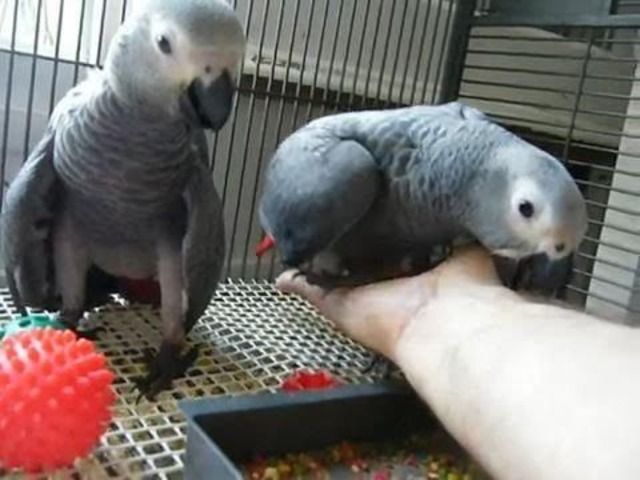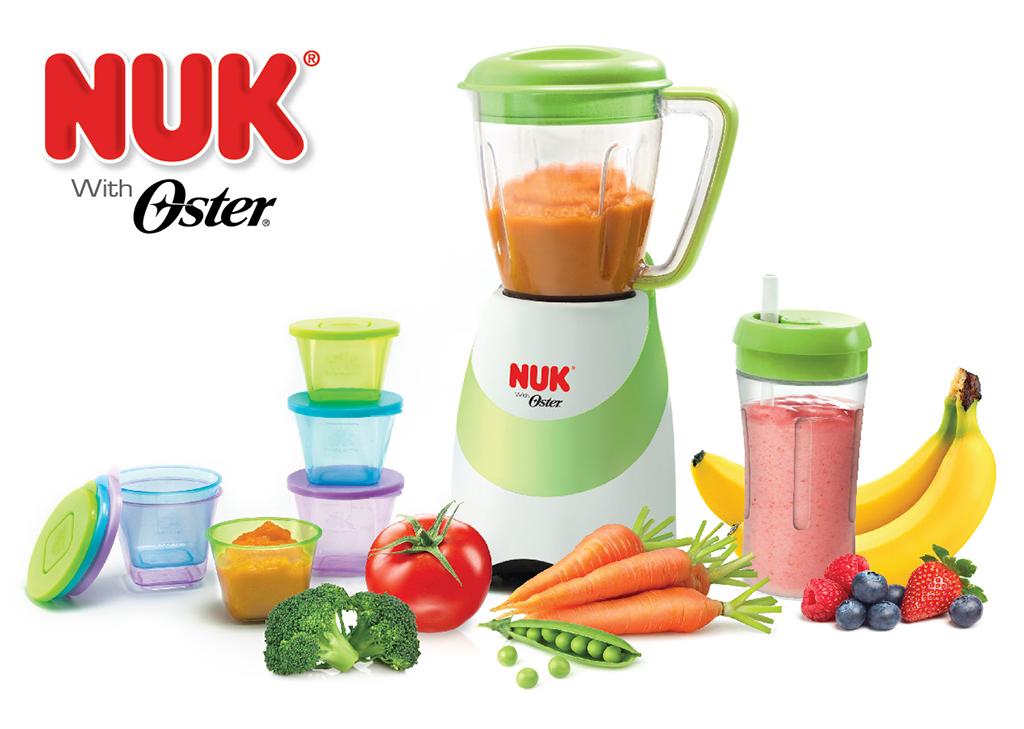Hand feeding baby african grey parrot
How Do I Hand-Feed an African Grey?
By Karen Mihayloi Hemera Technologies/PhotoObjects.net/Getty Images
African greys are usually attentive parents, but occasionally a clutch is abandoned and hand-feeding becomes necessary. An ill bird can also require hand-feeding. Hand-feeding an African grey parrot isn't difficult, with proper training and a little experience. To be prepared for an emergency when breeding African greys, ask your avian veterinarian or a reputable breeder for hands-on training before the eggs begin hatching.
Properly Prepared Formula Is Essential
Leave the baby in his nest or brooder while you clean and disinfect the preparation area, wash and dry your hands and prepare the formula. Mix warm bottled water with powdered formula, using a commercial baby parrot formula specifically formulated for African greys. Never heat prepared formula in a microwave; hot spots can burn the chick. Follow the manufacturer's directions carefully; dilution rates and feeding schedules vary according to the chick's age. Malnutrition, dehydration or an impacted crop are some of the problems that improperly diluted formula may cause.
Keep the Formula Warm
Use a thermometer to ensure the formula is between 103 and 108 degrees Fahrenheit, leaving it in the food during feeding. To keep the formula at the proper temperature, lower the feeding container into a bowl of very warm water. Stir the formula and check its temperature each time you fill the feeding syringe. Proper food temperature is crucial for healthy weight gain.
Initiate a Feeding Response
Keep your chick warm and away from drafts while feeding him. Gently touch the soft pad at the inner edge of his beak with the filled feeding syringe to initiate a feeding response. When the chick opens his beak, angle the syringe behind his tongue, toward the back or sides of his throat, avoiding the windpipe located in the center of his throat. Slowly depress the syringe while the crop, a pouch on the front of the chick's throat, plumps up. Don't allow the crop to overflow.
Don't allow the crop to overflow.
Clean the Chick After Feeding
Baby parrots are messy eaters, and must be cleaned immediately after being fed. Using a cotton swab moistened with warm water, thoroughly clean inside the beak. Any food particles stuck here can turn sour, which may cause a bacterial infection. Carefully clean his face with a soft, moist cloth. Even his nostrils may contain caked formula. Dry him thoroughly, and replace him in his brooder or nest to avoid a chill.
Allow His Crop to Completely Empty
An African grey chick's crop must empty at least once each day. Failure to allow emptying of the crop may result in sour crop and bacterial infections, the two most common problems seen in hand-fed chicks. Let the chick go unfed for seven hours overnight, which allows the crop to empty completely. Other potential problems include malnutrition, pneumonia caused by aspirated formula and health or behavioral problems caused by early weaning.
References
- BirdChannel.
 com: 14 Parrot Hand-Feeding Tips
com: 14 Parrot Hand-Feeding Tips - Hilltop Animal Hospital: Hand-Raising and Hand-Feeding Baby Birds
- Arizona Parrots: Dangers of Hand Feeding Baby Birds
Photo Credits
Writer Bio
Karen Mihaylo has been a writer since 2009. She has been a professional dog groomer since 1982 and is certified in canine massage therapy. Mihaylo holds an associate degree in human services from Delaware Technical and Community College.
Feeding your new baby - The world of African Greys
BRINGING YOUR BABY GREY HOME - FEEDINGBy: Christine Wanger
Young African Grey Parrots will learn to wean on to solid food at around the the age of 12 weeks. But just because a bird has been seen to eat solid food, this does not mean that the weaning process is done and your bird's hand-rearing formula can be forgotten. Many African greys can still be reliant on you for 'Top-up' feeds for many weeks to come. This is something which many breeders will not tell you as they want to farm the young birds out as soon as possible to keep costs as low as they can, get their cash and be sure the bird is still young and tame. Unfortunately many birds are sold as weaned and die of starvation a few days after being sold as the owner will not be informed that top up feeds are required. A bad scrupulous breeder will not care for the bird's fate as long as they get their hands on your cash! These kind of people will never offer you a refund, their only concern is the cash.
Unfortunately many birds are sold as weaned and die of starvation a few days after being sold as the owner will not be informed that top up feeds are required. A bad scrupulous breeder will not care for the bird's fate as long as they get their hands on your cash! These kind of people will never offer you a refund, their only concern is the cash.
Be prepared!
There are a few things you can do to prevent your newly purchased bird from starving to death. Firstly you need to be prepared! Ask the breeder what hand rearing formula the bird has been reared on and ask if you can purchase some. If they will not sell any to you or say they don't know, then buy one of the brands available in pet stores which say they are suitable for African Grey parrots. There are many good brands available on the market, the store owner may be able to advise you. Secondly ask the breeder if the bird was syringe fed or spoon fed. This will make booster feeding for you much easier if you have the right equipment that the bird will recognise and realise it's food time.
Is my new home ready?
When your bird arrives home with you, the cage and feed pots should already be in place. When setting up the cage remember that a young Grey will not be very good at climbing around and getting from perch to perch with ease. Most birds have come directly from a cage where they have been either on a perch very low to the bottom of the cage or even just the flat surface at the bottom of a cage. So it is very important to set up the cage with the perches placed down low in the cage until your bird learns to climb around. If your bird is having problems getting around the cage, it may have difficulties getting to the food and water pots too. I find it best to place the pots on the bottom surface of the cage away from the perch so they don't poop in it, weaning birds find it far easier to eat while on a flat surface rather than while perching. Also avoid water pots that are too deep as the bird may get chilled if it keeps falling into or standing in the water pot.
*Your birds main food pot should include a pot with at least half pellets and half seed mix. You should ask your breeder whether your bird has been weaned onto pellets or seed. Most will say seed as it is the cheaper option but a pelleted diet is so much more healthier and young birds are more willing to try them. Many young birds have difficulties shelling the seeds in their mix- this is usually something they will learn to do from their parents. So always try pellets- get them eating healthy while young!
Ok so your new bird is now home with you and settled - fantastic! After a few hours of being with you you will need to offer the bird some of the hand rearing formula which you have purchased. A great way to tell if your bird is hungry or needs topping up is to hold the bent teaspoon or syringe in front of your birds beak. If your bird is hungry it will recognise the feeding instrument and may begin to grab at it with its beak and flap its wings. If this happens be prepared as it can get messy until you master the art of hand feeding!
If this happens be prepared as it can get messy until you master the art of hand feeding!
Mix the formula as directed on the packaging and allow it to cool! *A good tip here is the temperature when ready to feed should be warm and not hot - you should be able to poke your finger into the centre without any burning, just a comfortable warmth. Your bird should only take a few teaspoons until it is full up. Make sure that you try to keep the formula away from the feathers and clean your birds beak after as it will matt the feathers and stick into a hard messy lump on the beak and feathers if not cleaned up. Job done!
DIET SHEET FOR WEANING BIRDS around 12 weeks old plus.
* A supply of fresh seed mix/pellets should be available all of the time.
Remember- your parrot will be unsure of how to shell seeds at this point and it may take lots of practice so the amount of seeds which are eaten will be minimal and other foods need to be offered. Weaning your bird onto a pelleted diet is a much healthier and easier option!
Weaning your bird onto a pelleted diet is a much healthier and easier option!
*A fresh supply of water should be available all the time.
*The first stage in weaning your African Grey is to gradually reduce the amount of hand rearing formula feeds. So firstly aiming at 3 feeds per day these should be equally spaced at about 8 hours apart. so for example:
*7am
*3pm
*11pm
*Inbetween feeds a fresh supply of fruit and veg should be offered. for example, between 7am and 3pm offer a dish of fruit and between the 3pm and 11pm feed offer a dish of vegetables.
* See list of safe fruit and vegetables for Ideas. At weaning age it is a good ides to offer fruits and veggies in small pieces. Peas and sweetcorn are often readily taken raw or cooked.
*Parrots are not keen on cold straight from the fridge foods and it can upset a young birds tummy so always try to serve at room temperature.
*Veggies are best served warm and are often refused when they have turned cold.
* Always remove any spoiled dirty foods immediately.
*Other foods can also be offered inbetween feeds. This is a good opportunity to offer things such as sprouted seeds and pulses, soft low fat and easy to eat foods such as scrambled egg, hard boiled egg (chopped), chopped roast chicken breast ( no bones), white boneless fish, a few sprinkles of grated cheese, boiled rice or pasta, a very small amount of biscuit crumbs, millet spray or seeds, wholegrain healthy cereals either soaked in soya milk or eaten on their own. Boiled sweet potatoe I find is also very well consumed at this age as it has a soft mushy consistancy.
As your bird gradually learns to eat more during the day, feeds can be reduced to 2 feeds per day, so one in the morning and one at night time just as top ups to ensure your bird is eating enough. These two feeds can be given for many weeks to come until your bird refuses them and decides he/she no longer wants them.
*African Greys do not like to be rushed through the weaning process so do not be in too much of a hurry to drop the final 2 feeds. In the wild African Greys do not learn to wean until they have first learnt to fly (around 12 weeks old) and the process of following their parents around and learning to eat different kinds of foods can take weeks or sometimes even months in the wild! But they can also rely on you too much for food so getting your bird eating healthy on a 3 formula feed diet rota followed by a 2 a day formula feed is a very healthy way to introduce your bird onto solid foods.
In the wild African Greys do not learn to wean until they have first learnt to fly (around 12 weeks old) and the process of following their parents around and learning to eat different kinds of foods can take weeks or sometimes even months in the wild! But they can also rely on you too much for food so getting your bird eating healthy on a 3 formula feed diet rota followed by a 2 a day formula feed is a very healthy way to introduce your bird onto solid foods.
*Purchasing some gram scales to weigh your bird is an excellent way to ensure your bird is eating enough and not loosing too much weight during the weaning process!
African Gray Parrot Care
Perhaps, among the large species of parrots, it is Jaco that is the most popular among lovers and breeders. The mind and amazing ability to imitate strikingly distinguishes him from the rest of his brethren. It is noticed that the parrot easily remembers about 100 turns of speech. In addition, the bird is able to associate the words of a person with the objects they designate and can perceive the concept of color, shape, serial number. And how cleverly Jaco copies the sounds made by birds flying on the street or household appliances! nine0003
And how cleverly Jaco copies the sounds made by birds flying on the street or household appliances! nine0003
Jaco parrots lived as pets in the homes of wealthy Romans and Greeks about 4,000 years ago. Under natural conditions, they live in tall forests of tropical and equatorial Africa. There are several subspecies of the parrot:
- red-tailed;
- brown-tailed;
- royal Jaco.
All individuals are quite large - the size of the parrot ranges from 30 to 35cm, weight - 350-400g. Species differ from each other in plumage color. Brown-tailed Jaco is slightly faster than red-tailed. Royal, in turn, is larger than its relatives and boasts a luxurious outfit with a predominance of red feathers. nine0003
Jaco is a social bird and very wayward. Sometimes finding an approach to an adult can be very difficult. If she doesn’t like something, she will show indignation with her whole appearance, turning into a piercing cry and even a whistle, from which the owner can literally lay her ears. To avoid such situations, first of all, you need to find an approach to the pet. And for this you need to create comfortable conditions for him.
To avoid such situations, first of all, you need to find an approach to the pet. And for this you need to create comfortable conditions for him.
First of all, it is worth remembering that Jaco loves freedom and space very much. Therefore, once and for all, imprisoning him in a cage will not work. In addition to the fact that the home for a parrot should be of an impressive size, it must be given access to the entire apartment. And here the owner should think about it, since traces of Jaco's stay in the form of feathers and down can be anywhere. nine0003
Another feature of a feathered pet is its tendency to reproduce various sounds. Even if he is left alone, he cannot help but chat. He needs to shout down the working TV, the owner speaking on the phone - be sure to “help”. There is even a funny joke on this subject that there are two types of parrot owners: those who try to teach the pet to talk, and those who try to convince the parrot to be silent.
Further, you should get used to the fact that the apartment will have to be cleaned much more often. The remains of food, fluff, chips from chewed toys will become a permanent “decoration” of the carpet and the nearest corners. Most birds of this breed eat like “pigs”, and despite the protective partitions in the cage, pieces of food will certainly lie outside it. nine0003
The remains of food, fluff, chips from chewed toys will become a permanent “decoration” of the carpet and the nearest corners. Most birds of this breed eat like “pigs”, and despite the protective partitions in the cage, pieces of food will certainly lie outside it. nine0003
Birds are very attached to the owner and can experience real stress when he leaves for a long time. Despite his personality, he can be affectionate and sympathetic. In his person you can find a true friend with whom it will be interesting and entertaining for 40-50 years. And it's worth a lot!
Siamese cock - a fish with character
More details
Cat care after spaying
More details
Peculiarities of dog diet during pregnancy
Read more
Compiling a diet for a guinea pig
Read more
Feeding parrot chicks | Tail News
Contents
one Feeding parrot chicks on your own 2 How to prepare and give the mixture? nine0003
3 minutes
estimated reading time
Breeding parrots is an exciting but very responsible process. When breeding, you need to be prepared for a number of difficulties. Often, the newly-born mother refuses her offspring, and then the care of the life of the chicks falls entirely on the shoulders of the person. How to proceed in this case? Is it possible to feed chicks left without mother's care?
When breeding, you need to be prepared for a number of difficulties. Often, the newly-born mother refuses her offspring, and then the care of the life of the chicks falls entirely on the shoulders of the person. How to proceed in this case? Is it possible to feed chicks left without mother's care?
nine0002 Mother rejection of clutch or already hatched chicks is a serious problem faced by many bird owners. Unfortunately, the probability of death of babies in this case is very high, so you need to respond quickly and correctly.
In nature, the first food of chicks is goiter mother's milk. It provides babies with all the necessary nutrients and serves as the basis for rapid and harmonious growth. But under the influence of various factors, the female may refuse to feed her offspring or begin to show aggression towards him, and she has to be isolated. If it is possible to "put" the chicks to another feeding bird, the problem is usually solved. Another parrot takes care of other people's offspring and raises healthy chicks. But, you see, not every breeder will have several lactating females at the same time, which means that the owner has to organize the feeding of parrot chicks on his own. nine0003
Another parrot takes care of other people's offspring and raises healthy chicks. But, you see, not every breeder will have several lactating females at the same time, which means that the owner has to organize the feeding of parrot chicks on his own. nine0003
Feeding parrot chicks by yourself
Experienced craftsmen can feed babies with natural food, preparing liquid gruels from semolina or wheat groats on the water. However, there are a huge number of nuances in feeding chicks, which are extremely difficult to take into account with a natural type of feeding (for example, a strict balance of fats and proteins). The chicks are very weak, and any, even seemingly the most insignificant mistake (insufficient quality cereals and water, the presence of seasoning, etc.) can lead to fatal consequences. Whether it is worth risking the health of newborn crumbs is up to you. But we recommend that you approach the issue professionally and use a special ready-made mixture for feeding parrot chicks. nine0003
nine0003
On the Russian market, such a mixture is represented by the Micropills Baby Birds line. This is a ready-made, carefully balanced mixture that is suitable for the chicks of any parrots and other birds. It is made from delicate fine flour (wheat, peas, chickpeas, lentils) and does not contain soy. The composition of the mixture includes fructose - a natural source of carbohydrate for parrots, and wheat gluten and table egg protein act as a protein source. The complex of nutraceuticals, which is also part of the mixture, strengthens the body and promotes the proper development of organs, which is very important for a fast metabolism. How to use such a mixture? nine0003
You will need boiling water to dilute the mixture. The proportions of mixture and water depend on the days of feeding and are calculated in accordance with the attached instructions. For example, in Micropills Baby Birds:
-
1st day: 1 part food to 4 parts water;
-
2-3rd day: 2 parts food to 3 parts water;
-
Days 4-15: 3 parts food to 3 parts water; nine0003
-
from day 16: 5 parts food to 3 parts water.

The first feeding should be carried out 12 hours after the chicks have hatched. While they are very small, it is recommended to feed them once every two hours. Over time, the interval between feedings increases. You can regulate it by filling the goiter in the chicks.
How to prepare and give the mixture? nine0062
The optimal amount of the mixture is poured with boiling water and infused for several minutes. When the temperature of the resulting slurry drops to 38 ° C (but not lower than 36 ° C), it is thoroughly stirred and manually given to the chick (from a syringe without a needle or from a special spoon). The finished mixture is not subject to storage, and for each meal the mixture is diluted anew.
The whole cooking process takes a few seconds, and this is very convenient, as it provides significant time savings. All components are calculated in the finished mixture, and you no longer have to worry about the quality of food for the chick. nine0003
nine0003
Many breeders supplement the chicks with clean water, but this is not necessary, as the porridge contains enough liquid for the chicks.
Gradually, you need to start feeding the kids from a teaspoon. Chicks must learn to take food from a spoon on their own. As a rule, at first they eat without appetite, but, having got used to it, they themselves open their beak at the sight of a spoon brought to them.
Birds grow very quickly, and when your parrot is 1 month old, it can already be transferred to adult food - most importantly, gradually. Usually, special balanced ready-made feeds are introduced into the diet of the chick as soon as he learns to fly. When choosing food, give preference to trusted brands, because the health of your wards depends on the quality of the diet. nine0003
Do not forget about clean water and mineral stone (or top dressing). From the moment of transfer to adult food, they should always be in a cage.
Health to your chicks, and let them grow bright and strong!
Other related articles
How to feed a parrot?
Prevention of problems with the gastrointestinal tract.











